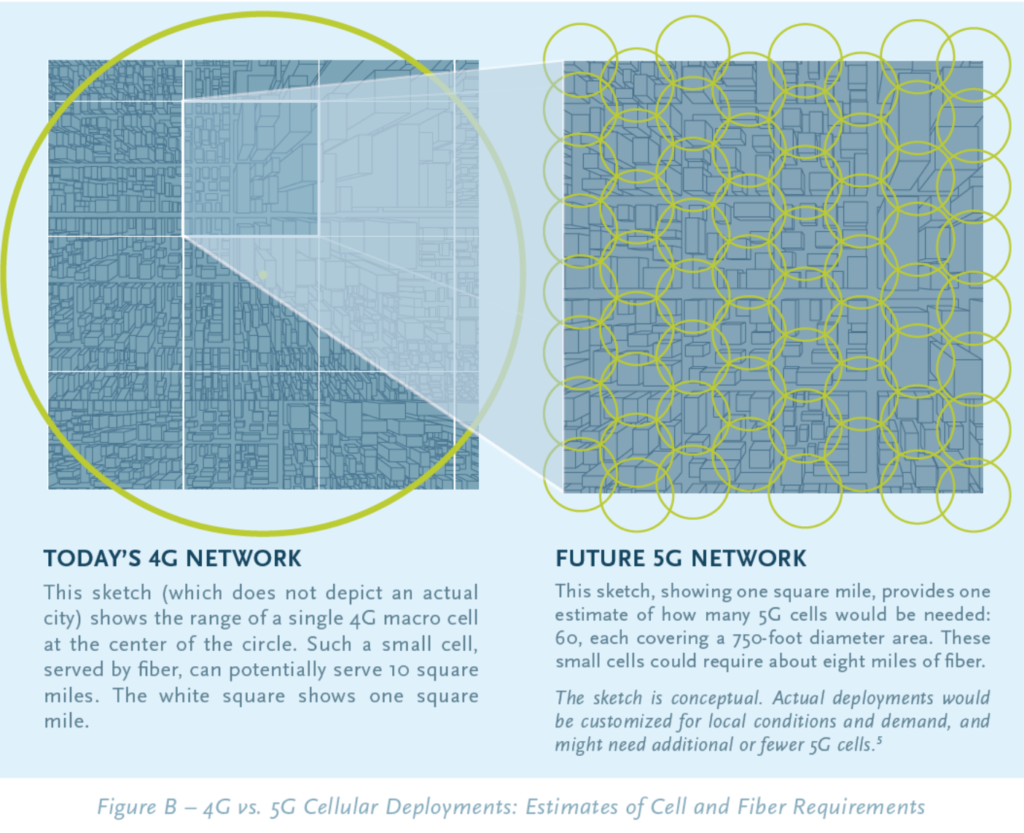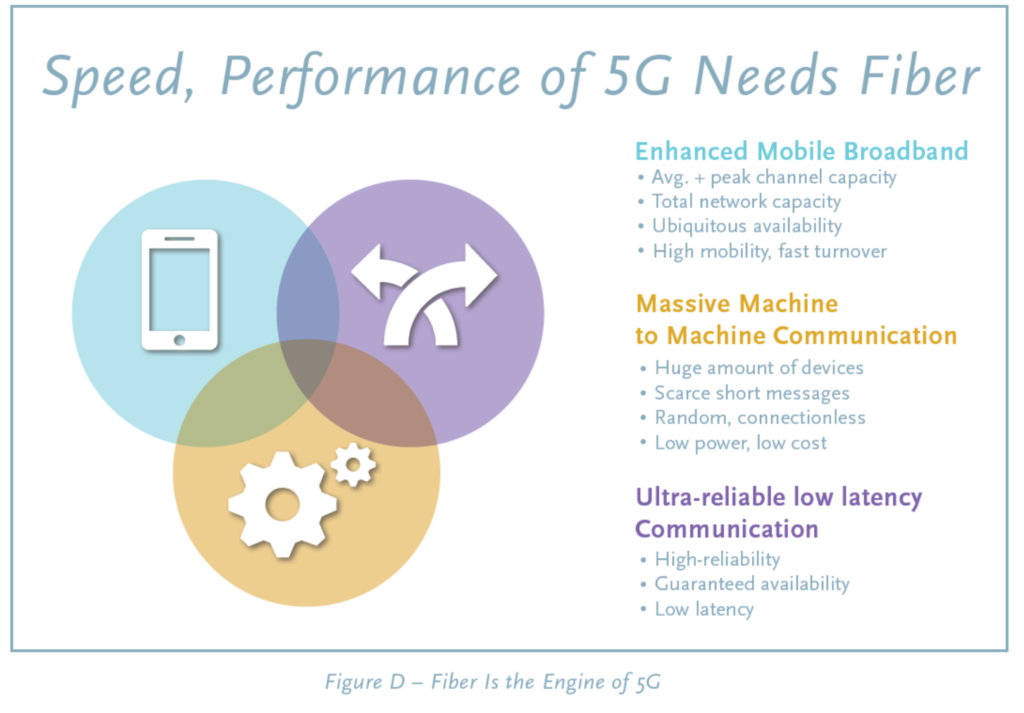
5G isn’t fully here yet, but it soon will be.
We live in a world of constantly streaming phones, TVs, and tablets, where the average American broadband household has seven video-playing devices according to Parks Associates.
Think about your own usage. How many hours do you spend binge-watching the latest season of Stranger Things or Orange is the New Black?
Or if you have kids with smartphones, how much time do they spend watching YouTube videos?
Probably more hours than you’d care to admit. But the truth is, this behavior is common among Americans of all ages, and it’s only expected to increase.
And with burgeoning technologies like autonomous vehicles, virtual reality (VR), smart sensors, and cloud-based apps for various industries, we can expect the need for higher speed connectivity to grow.
So, 5G – which is 1,000 times faster than a 4G network and can download an 800MB movie in 1 second – will be the conduit we need for the mobile world of the future.
But when we talk about the actual deployment of 5G networks in the U.S., the best methods to do so are up for debate – especially when you get down to the nuts and bolts of how to deploy it to consumers.
There is one method worth exploring which the Fiber Broadband Association highlighted in their 2017 whitepaper, “Paving the Road to 5G with Fiber,” and which Clearfield Director of Application Engineering Brand Schrand presented at a fiber-related conference in March 2018: a network design incorporating both wireless equipment and fiber to the home (FTTH) delivery.
Learn about what this network design would look like and how the high radio frequency of 5G will affect its deployment in today’s blog post.
5G, High Radio Frequencies & Small Cells
In order to be 10+ times faster than 4G, 5G will operate differently than its predecessor. It will use high radio frequencies that could range from 30 GHz to 300 GHz to carry a wide amount of data.
But there’s a caveat: though these frequencies can carry more data than 4G, their range is limited.
The Fiber Broadband Association explains in their whitepaper that “achieving these higher data rates is only possible at a range of one-tenth to one-fifteenth the distance covered by 4G LTE.”
To make up for this shorter range, the U.S. will need a dense array of 5G radios – also called “cells” – clustered close together. The cells will vary in size, but the distance between each should be between 200 and 1,000 feet, the Fiber Broadband Association claims.
But we won’t just need more cells.
We will also need more fiber.
Not every cell will need to be directly connected to a fiber-optic network, but for large metropolitan areas which constantly use and stream data (cities in particular), this direct connection may be needed.

In his 5G presentation about this topic in March, Brian Schrand broke down Figure B (see above) from the Fiber Broadband Association whitepaper a bit further.
As you can see in this figure, one fiber-fed tower can potentially feed 10 square miles with 4G.
But with 5G, we would need 60 small cell sites per square mile with an average of 8 miles of fiber backhauling for each.
As such, 5G would require 480 miles of fiber to operate to its full capacity.
FTTH & Wireless Connections: The Perfect Combination for 5G
Fiber-optic networks provide many benefits to businesses and consumers alike. From decreased latency to greater bandwidth, there are various reasons that fiber is an excellent choice for connectivity.

But using fiber the way we do now may not be sufficient for the 5G’s limited range of radio frequencies.
The Fiber Broadband Association writes that fiber “is not an easy replacement for wired connections to homes and businesses because common building materials substantially block high-frequency 5G signals.”
Fortunately, there’s a way around this: incorporated FTTH and wireless connections.
FIBER TO THE HOME (FTTH)
FTTH is a fiber optic communication delivery form which typically consists of a wireless router found in a consumer’s home or a business. This router is connected to an optical network terminal (ONT), which is then connected to a network access point, or NAP.
NAPS are important because Internet service providers (ISPs) connect with each other in peering arrangements using NAPs.
A NAP is usually connected to a fiber distribution hub (FHD), which is an enclosure that serves as a connection between optical splitters and fiber-optic cables. The FHD has a direct connection to the fiber-optic network itself.
THE FTTH & FIXED WIRELESS NETWORK SOLUTION
In his presentation, Schrand discussed the secondary possibility of a network that incorporates both FTTH and wireless designs.
In this network layout, a home would still have a router, but it would be connected to an antenna on the rooftop.
The router would communicate with a cell tower or a small 5G cell that would be directly connected to the FDH, which would be directly connected to the fiber network.
This new network design would provide several tangible benefits.
Schrand pointed out that a community’s network would be designed for both current and future bandwidth needs, would offer 1 Gig service to customer premises, and would give consumers the capability to move between both the mobile and the FTTH network.
How Independents Fiber Network Can Help
Independents Fiber Network maintains high-reliability, high-capacity connectivity with a growing network of technology-driven, community-focused service providers who are focused on delivering broadband connectivity and services to their residential and business customers.
Conclusion
If Paul Revere lived today and worked for a tech company, he would be riding his self-driving car or electric-powered scooter through the streets of modern-day America, live streaming a Facebook video or Instagram story and announcing: “5G is coming! 5G is coming!”
Like the colonists, we need to prepare for the advent of 5G in the U.S. (Better 5G than an impending battalion of British Redcoats, we could argue.)
Fortunately, there are affordable and achievable methods to deploy this faster connectivity to businesses and homes in the U.S.
Fiber, when incorporated into a FTTH and wireless network design, could prove to be the cost-effective solution we need to get ready for the faster mobile networks of the future.
